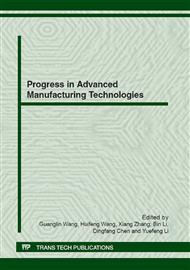p.236
p.240
p.245
p.251
p.256
p.260
p.264
p.268
p.272
Dynamic Design of Six-Station Automatic Hydraulic Stretching Machine
Abstract:
Hydraulic stretch forming is a very important technology. Punch press has achieved multi-station automatic processing in the press area, which has greatly improved the efficiency. However, the main domestic stretching machine is single-stretching hydraulic machine at present. Compared with punch press, hydraulic stretching machines take less space and have better security, but they make less efficiency and have lower degree of automation. Hence, in order to take the advantage of hydraulic stretching machines and enhance the automation level, studies on multi-position automatic stretching machine occupies an important position. This paper proposes a design scheme of Six-station Automatic Hydraulic Stretching Machine (SAHSM) according to the practical production. The overall 3D structure of SAHSM is designed based on Solidworks to prove the theoretical possibility of the program. Then modal analysis is operated based on FEA of the key components of stretching machine module to improve reliability of the product and overcome the disadvantage of the traditional checking method, the first two-order modes are obtained to prove the impossibility of the resonance. At last, ADAMS-based virtual prototype is analyzed to demonstrate the feasibility and effectiveness of the SAHSM dynamic design proposed in this paper
Info:
Periodical:
Pages:
256-259
Citation:
Online since:
August 2012
Authors:
Keywords:
Price:
Сopyright:
© 2012 Trans Tech Publications Ltd. All Rights Reserved
Share:
Citation:


